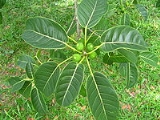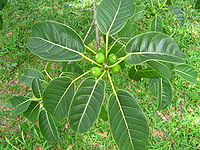
Ficus citrifolia
Encyclopedia
Ficus citrifolia, also known as the Shortleaf Fig, Giant Bearded Fig or Wild Banyantree, is a species of banyan
native to southern Florida
, the Caribbean
, Central America
, and northern South America
south to Paraguay
. It is distinguished from the closely related Florida Strangler Fig (Ficus aurea
) mainly by the finer veining in the leaves
.
 Ficus citrifolia trees typically grow 15 m (50 ft) tall, and may cover a wide area due to their ability to drop aerial roots from branches and spread horizontally, fusing with the parent tree as they grow. They have a broad top, light grey bark, some aerial roots and milky sap. The leaves of F. citrifolia are dark green. They are oval shaped with a rounded base and pointed tip. Small flowers are enclosed in open ended fruit. The fruit appears on the ends of long stalks protruding from the leaf axils. Fruit turn from yellow to dark-red when ripe. This fruit is sweet and can be eaten raw.
Ficus citrifolia trees typically grow 15 m (50 ft) tall, and may cover a wide area due to their ability to drop aerial roots from branches and spread horizontally, fusing with the parent tree as they grow. They have a broad top, light grey bark, some aerial roots and milky sap. The leaves of F. citrifolia are dark green. They are oval shaped with a rounded base and pointed tip. Small flowers are enclosed in open ended fruit. The fruit appears on the ends of long stalks protruding from the leaf axils. Fruit turn from yellow to dark-red when ripe. This fruit is sweet and can be eaten raw.
, a strategy which allows them to avoid competition for light and land. F. citrifolia commonly attacks palms, bald cypress
, oak
s and other trees, strangling them as it grows.
Ficus citrifolia is under strong selective pressure to flower and produce fruit year round due to its mutualistic relationship with its pollinating agaonid
wasp. Agaonid wasps have a symbiotic relationship with figs such that a given agaonid species acts as a pollinator for just one species of fig, and a particular fig species is pollinated by just one species of wasp. F. citrifolia is pollinated by P. asseutus. After pollination, figs ripen quickly. Fruit bearing figs are heavily laden; a single tree may produce up to 1,000,000 fruits with a diameter of 1-2.5 cm. The fruit of F. citrifolia tends to have a purgative effect on the digestive systems of many animals; ripe fruits are eaten and seeds are spread widely through dung.
keystone species
. Figs are a major component of the diets of more species of animals than any other tropical perennial fruit. Since F. citrifolia fruits year round many primates, birds and other species, feed exclusively on figs during seasons when other fruit is scarce. Additionally, the knobby, hollow, lattice-like trunk of this tree provides a home for thousands of invertebrates, rodents, bats, birds and reptiles.
F. citrifolia is considered common and is not in danger of extinction.
its name. It appears on the coat of arms of Barbados
, and the removal of one specimen, over 100 years old, was enough to draw attention.
patients.
This page includes high resolution photos of the leaves and fruit of F. citrifolia, as well as basic taxonomic information and species distribution information. It includes a wealth of links to related and elaborative websites and pages, both internal and external to Discover Life.
Banyan
A banyan is a fig that starts its life as an epiphyte when its seeds germinate in the cracks and crevices on a host tree...
native to southern Florida
Florida
Florida is a state in the southeastern United States, located on the nation's Atlantic and Gulf coasts. It is bordered to the west by the Gulf of Mexico, to the north by Alabama and Georgia and to the east by the Atlantic Ocean. With a population of 18,801,310 as measured by the 2010 census, it...
, the Caribbean
Caribbean
The Caribbean is a crescent-shaped group of islands more than 2,000 miles long separating the Gulf of Mexico and the Caribbean Sea, to the west and south, from the Atlantic Ocean, to the east and north...
, Central America
Central America
Central America is the central geographic region of the Americas. It is the southernmost, isthmian portion of the North American continent, which connects with South America on the southeast. When considered part of the unified continental model, it is considered a subcontinent...
, and northern South America
South America
South America is a continent situated in the Western Hemisphere, mostly in the Southern Hemisphere, with a relatively small portion in the Northern Hemisphere. The continent is also considered a subcontinent of the Americas. It is bordered on the west by the Pacific Ocean and on the north and east...
south to Paraguay
Paraguay
Paraguay , officially the Republic of Paraguay , is a landlocked country in South America. It is bordered by Argentina to the south and southwest, Brazil to the east and northeast, and Bolivia to the northwest. Paraguay lies on both banks of the Paraguay River, which runs through the center of the...
. It is distinguished from the closely related Florida Strangler Fig (Ficus aurea
Ficus aurea
Ficus aurea, commonly known as the Florida strangler fig , golden fig, or higuerón, is a tree in the family Moraceae that is native to the U.S. state of Florida, the northern and western Caribbean, southern Mexico and Central America south to Panama...
) mainly by the finer veining in the leaves
Leaf
A leaf is an organ of a vascular plant, as defined in botanical terms, and in particular in plant morphology. Foliage is a mass noun that refers to leaves as a feature of plants....
.
Description

Ecology
New trees begin their life as an epiphyteEpiphyte
An epiphyte is a plant that grows upon another plant non-parasitically or sometimes upon some other object , derives its moisture and nutrients from the air and rain and sometimes from debris accumulating around it, and is found in the temperate zone and in the...
, a strategy which allows them to avoid competition for light and land. F. citrifolia commonly attacks palms, bald cypress
Taxodium
Taxodium is a genus of one to three species of extremely flood-tolerant conifers in the cypress family, Cupressaceae...
, oak
Oak
An oak is a tree or shrub in the genus Quercus , of which about 600 species exist. "Oak" may also appear in the names of species in related genera, notably Lithocarpus...
s and other trees, strangling them as it grows.
Ficus citrifolia is under strong selective pressure to flower and produce fruit year round due to its mutualistic relationship with its pollinating agaonid
Fig wasp
Fig wasps are wasps of the family Agaonidae which pollinate figs or are otherwise associated with figs, a coevolutional relationship that has been developing for at least 80 million years...
wasp. Agaonid wasps have a symbiotic relationship with figs such that a given agaonid species acts as a pollinator for just one species of fig, and a particular fig species is pollinated by just one species of wasp. F. citrifolia is pollinated by P. asseutus. After pollination, figs ripen quickly. Fruit bearing figs are heavily laden; a single tree may produce up to 1,000,000 fruits with a diameter of 1-2.5 cm. The fruit of F. citrifolia tends to have a purgative effect on the digestive systems of many animals; ripe fruits are eaten and seeds are spread widely through dung.
Keystone species
Ficus citrifolia is considered a tropicalTropics
The tropics is a region of the Earth surrounding the Equator. It is limited in latitude by the Tropic of Cancer in the northern hemisphere at approximately N and the Tropic of Capricorn in the southern hemisphere at S; these latitudes correspond to the axial tilt of the Earth...
keystone species
Keystone species
A keystone species is a species that has a disproportionately large effect on its environment relative to its abundance. Such species play a critical role in maintaining the structure of an ecological community, affecting many other organisms in an ecosystem and helping to determine the types and...
. Figs are a major component of the diets of more species of animals than any other tropical perennial fruit. Since F. citrifolia fruits year round many primates, birds and other species, feed exclusively on figs during seasons when other fruit is scarce. Additionally, the knobby, hollow, lattice-like trunk of this tree provides a home for thousands of invertebrates, rodents, bats, birds and reptiles.
F. citrifolia is considered common and is not in danger of extinction.
Genetic mosaics
F. citrifolia may fuse with figs of other species types, creating a cumulate tree that is a genetic mosaic. Research suggests that the frequency of genetic mosaicism among strangler figs may be quite high; it is unknown how this variation effects flowering in mosaic figs. (Thomson et al., 1995). Thomson et al. suggest that if genetically different segments of a single tree flower asynchronously, agaonid wasp populations may be more resistant to low host population sizes that previously thought. Alternatively, genetic mosaicism could mean that the number of certain varieties of fig in an ecosystem may be far lower than biologists have previously thought, and given populations may not have enough trees to maintain their symbiotic relationship with their pollinating wasps.History
One theory is that the Portuguese name for F. citrifolia, "Os Barbados", gave BarbadosBarbados
Barbados is an island country in the Lesser Antilles. It is in length and as much as in width, amounting to . It is situated in the western area of the North Atlantic and 100 kilometres east of the Windward Islands and the Caribbean Sea; therein, it is about east of the islands of Saint...
its name. It appears on the coat of arms of Barbados
Coat of arms of Barbados
The coat of arms of Barbados was adopted upon independence in 1966 by decree of Queen Elizabeth. Like other former British possessions in the Caribbean, the coat of arms has a helmet with a national symbol on top, and a shield beneath that is supported by two animals.The national symbol found on...
, and the removal of one specimen, over 100 years old, was enough to draw attention.
Medicine
An extract of F. Citrifolia may have therapeutic value for chemotherapyChemotherapy
Chemotherapy is the treatment of cancer with an antineoplastic drug or with a combination of such drugs into a standardized treatment regimen....
patients.
External links
This page includes high resolution photos of the leaves and fruit of F. citrifolia, as well as basic taxonomic information and species distribution information. It includes a wealth of links to related and elaborative websites and pages, both internal and external to Discover Life.

